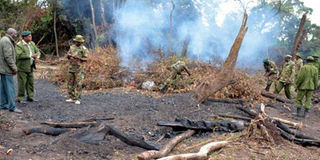Protect and replenish our forests before it is too late

Narok County security enforcement team destroys 500 sacks of charcoal in Nyakweri Forest on March 1, 2018. Conservation, afforestation and reforestation must be a matter of urgency. PHOTO | GEORGE SAYAGIE | NATION MEDIA GROUP
What you need to know:
- State must ensure sustainable exploitation, utilisation, management and conservation of the environment and natural resources.
- A revamped KFS and the Environment Ministry can turn the tide and implement plans that ensure indigenous forests are protected.
- Logging of mature trees must be allowed only when intricate plans are in place to replant and replenish the forest plots.
Deputy President William Ruto recently directed that logging be banned for three months to pave way for a task force meant to prepare a status report on the forest sector and propose appropriate remedial measures to check destruction of the environment.
This comes when reports indicate that rivers are drying up, water rationing is being rolled out in towns, biting famine is in the offing and millions of Kenyans are in danger of starvation. Suffice it to say, rain surely comes from trees!
According to the Constitution, the State must ensure sustainable exploitation, utilisation, management and conservation of the environment and natural resources; ensure the equitable sharing of the accruing benefits; and, work to achieve and maintain a tree cover of at least 10 per cent of the land area of Kenya – a far cry from the current 1.7 per cent.
MAU FOREST
This directive coincided with a trip that took me through Molo and Kipkelion on my way to Kisumu, and later Burnt Forest, Timboroa, Makutano and Equator areas on the Eldoret-Nakuru road.
What immediately grabbed my attention was that the previously scenic view of endless forest had all but disappeared, leaving behind bare land with small patches of trees and smoke billowing from several areas.
Also, a recent flight from Nairobi to Kisumu gave me a bird’s eye view of the extent to which the Mau Forest had been depleted.
KERIAKO TOBIKO
The dwindling forests also came up when Mr Keriako Tobiko, the new Environment and Natural Resources Cabinet Secretary, was being vetted by Parliament.
He rightly said that he would go after officials who were allowing the logging spree.
The yet-to-be formed task force will discover that the situation is dire; that powerful cartels are behind the wanton logging; and, that the Kenya Forest Service has been sleeping on the job and perhaps needs an overhaul.
It is vital that its findings and recommendations are followed to the letter. Still, is anyone going to be held accountable?
The KFS is a statutory agency mandated with the management and conservation of forests in Kenya.
KENYA FOREST SERVICE
As it stands now, it is a creature of the Forest Conservation and Management Act, which was operationalised on March 31, 2017.
It is to provide for the development and sustainable management, including conservation and rational utilisation, of forest resources for the socio-economic development of the country and connected purposes, including liaising with county governments in the preservation of community woodlands. How is it that KFS never raised the red flag over the current situation?
The KFS is the only institution that is in a position to provide answers on the status of forests; companies and individuals with logging permits; criteria for awarding permits; and, what measures have been taken against illegal logging.
In fact, the Forest Conservation Act requires KFS to prepare Forest Status Report for the Cabinet Secretary once every two years and a Resource Assessment Report once every five years.
The importance of the Mau, Mt Kenya and other water towers cannot be denied. They are crucial for regulating river flow, acting as a carbon sink, purifying air and water, flood and mudslide mitigation among others.
KITUICHARCOAL
All the forward leaps in agriculture, infrastructure, commerce, hydro-electricity, tourism and water supply will amount to nothing if we allow the decimation of Kenya’s forests and wetlands.
Conservation, afforestation and reforestation must be a matter of urgency.
It is noteworthy that the recent burning of a lorry ferrying charcoal in Kitui County and the protests in Limuru over the same is just but a taste of how environmental exploitation that is unregulated, especially in a toxic political/tribal environment, can cause civil unrest in this day and age.
More severe droughts occasioned by depletion of water towers and other national resources such as wetlands will inevitably cause or exacerbate security challenges in the border areas such as Elgeyo-Marakwet, Baringo, West Pokot, Laikipia, Samburu, Turkana, Tana River, Marsabit, Garissa, Mandera, Kitui and Isiolo counties.
CONSERVATION
It is not too late. A revamped KFS and the Ministry of Environment can turn the tide and implement programmes to ensure indigenous forests are protected and that other forests are managed in a way that protects our biodiversity, livelihoods and water towers.
Logging of mature trees must be allowed only when intricate plans are in place to replant and replenish the forest plots. Additionally, operations of the KFS must be open to public scrutiny.
Kenyans must be made aware of how their precious resources such as forests are being managed.
Parliament must ensure that KFS has the resources and the right personnel for conservation.
Writer is senior legal officer - ARTICLE 19 Eastern Africa; [email protected] Twitter: @kipdemas





